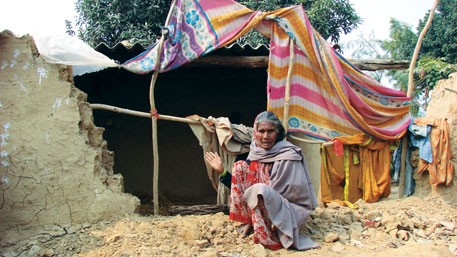Govt identifying real homeless, landless

By Indira Aryal
Kathmandu, Dec. 21: The government has initiated a process of identifying the real homeless and landless people in Nepal. The identification has already begun as a pilot study in Belaka Municipality Ward No.3 of Udayapur district in eastern Nepal.
In the survey conducted in the municipality, it was found that people of 1200 households are staying in the unclaimed government land. These people in the municipality have occupied land from three dhur (546.6 sq. ft) to nine bighas (656,100 sq. ft) per household.
The study even found that out of total 1783 households, 283 of them have occupied the government land, but these people are not landless people. This process of identifying the landless people will be conducted all over Nepal.
The identified landless and homeless people shall be provided with the land ownership certificate.
According to Minister for Land Management, Cooperatives and Poverty Padma Aryal, the government has set up Landless Settlers Problem Resolution Committee, but has been unable to distribute the certificate as the bill is yet to be authenticated by the President.
The Bill related to Land (Eighth Amendment), 2019 registered at the Federal Parliament Secretariat has stipulated a provision for providing land to the landless squatters.
According to the Section 18 of the bill, the landless squatters who have been using the government or unrecorded lands for at least 10 years now shall be entitled to a certain parcel of such land or any other government land.
As per the bill, the federal government shall maintain coordination with the concerned provincial government and local level prior to taking any decision related to providing land to the landless squatters.
Minister Aryal said that the ministry was working hard to resolve the problem of landless people. The government will provide the land ownership certificate after identifying the real landless people.
The government is working in collecting data from all around the country and identifies the real landless people. The problem is more in the Terai region.
According to a paper prepared by Leitner Centre for International Law and Justice Fordham Law School there up to 25 per cent of Nepal’s population estimated to be landless or near-landless. The bottom 47 per cent of agricultural households control only 15 per cent of agricultural land.
The problems of landless people are in 25 of Nepal’s 75 districts so far. The committee will distribute the land mainly in the Midwestern Region, where much of the landless population lives.
Recent News

Do not make expressions casting dout on election: EC
14 Apr, 2022
CM Bhatta says may New Year 2079 BS inspire positive thinking
14 Apr, 2022
Three new cases, 44 recoveries in 24 hours
14 Apr, 2022
689 climbers of 84 teams so far acquire permits for climbing various peaks this spring season
14 Apr, 2022
How the rising cost of living crisis is impacting Nepal
14 Apr, 2022
US military confirms an interstellar meteor collided with Earth
14 Apr, 2022
Valneva Covid vaccine approved for use in UK
14 Apr, 2022
Chair Prachanda highlights need of unity among Maoist, Communist forces
14 Apr, 2022
Ranbir Kapoor and Alia Bhatt: Bollywood toasts star couple on wedding
14 Apr, 2022
President Bhandari confers decorations (Photo Feature)
14 Apr, 2022











